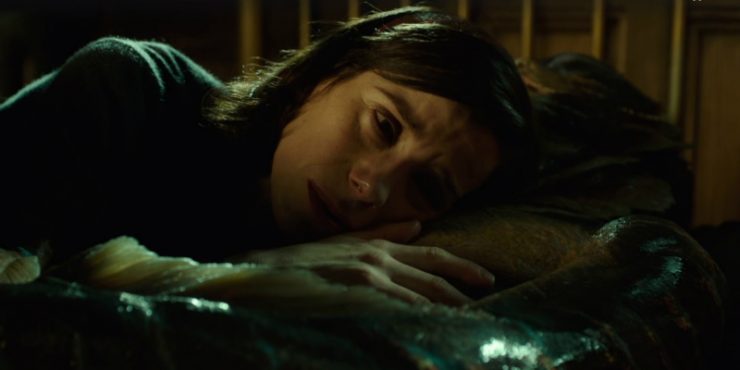The way in which Guillermo del Toro views his cinematic worlds is always fascinating, always captivating, even in movies as flat as Pacific Rim and Crimson Peak. It really is up to del Toro and his capacity as a director, whether his films are phenomenal or preposterous, whether his carnivorous need to thrill will overcome his need to tell a functioning story. The Shape of Water has all of things we expect from the Mexican director: breathtaking visual effects and production design, provocative stories influenced by traditional Hollywood archetypes, and perhaps a little but too much pressure on the audience to buy into its odd premise. His latest film is sweet, sometimes cavity-inducing, but it is also remarkably tender. It’s a cinematic take on love unlike any I’ve ever seen.
Sally Hawkins plays Elisa, a mute cleaning woman at a US government research facility in Baltimore. An orphan, she hasn’t spoke at any point in her memory. This makes her a good listener, and a great companion for other lonely, world-weary Baltimoreans. Her best friend is her neighbor, Giles (a terrific Richard Jenkins), a frustrated commercial artist and closeted homosexual who rarely leaves his apartment. She also gets along well with her fellow janitor Zelda (Octavia Spencer), a hard-working woman with a thankless job and a thankless husband. Her only time to vent her frustrations are at work, and Eliza is more than happy to hear them. She seems content to exist as a recipient for others’ complaints, that is until she meets something unlike anything else in the world.
It is often referred to as “The Asset”. It is a seeming part-man, part-fish amphibian man (played in very detailed make-up and costuming by Doug Jones) brought to the research facility from South America where it was rumored to be treated as a God. It was brought to Baltimore by Richard Strickland (Michael Shannon), a military man turned government worker whose hardened soul shows itself in harsh, dictatorial behavior to all members of the research facility. Strickland suggests to higher-ups that The Asset be killed, taken apart, and studied from the inside, while Dr. Robert Hoffstetler (Michael Stuhlbarg) thinks the Asset is too valuable as a source of knowledge to kill. As Strickland and Hoffstetler debate fiercely over the Asset’s fate, Elisa visits the creature in secret, and for the first time in a long time, she feels something like romance – for something that isn’t even human.
The film’s script (written by Vanessa Taylor and del Toro) is a tight, tidy affair that could actual do with being a bit looser. It pulls its pieces from a number of other cinematic hallmarks, most notably from The Creature From the Black Lagoon but also films as varied as E.T.: The Extra-Terrestrial to The Purple Rose of Cairo. Despite this, The Shape of Water still goes out of its way to give all of its major characters substantive backstories. Zelda, Giles, Strickland and Hoffstetler are all given a good amount of background motivation, with is interesting when you consider how little is given to Elisa. And yet, she’s the film’s most interesting character. In its best moments, we are not focused on obligatory character development, but the emotion of the actions. A sequence in which Elisa and Giles attempt to free the Asset from his prison is the movie’s best sequence – it manages to eventually include all of the film’s major characters – because it is the least weighed down by screenwriting mechanics.
I don’t mean to find fault with the film’s need to find empathy with each character it finds. In fact, I admire it. The Shape of Water has an impressively egalitarian view of love, of sadness and loneliness, of the nature of oppressing and being oppressed. The multitude of ways in which love and hate are shown throughout the film speaks to a diversity of feeling that del Toro seems eager to display. It’s a very earnest attempt to show the spectrum of the human experience, though it too often uses easy explanations to show us why these people are the way they are. The film’s early 1960’s American setting – that curious time before the Cold War went bitter cold – adds to this rush of feeling, as the idealism of the 50’s melts into the turbulence of the Civil Rights Movement and the Vietnam War. This tectonic shift in national feeling runs throughout the story.
The promotion for The Shape of Water doesn’t hide it: the heart of the movie deals with Eliza’s eventual love affair with the Asset. The sincerity in which this love is shown, with the rosy magic of the Golden Age of Hollywood, adds to the movie’s intentional strangeness. That The Shape of Water ends up becoming shockingly violent shouldn’t be a surprise to those familiar with del Toro, but he’s specifically contrasting genres here in a way that’s quite coy and provocative. It almost feels like a bait-and-switch. That del Toro mostly pulls it off is an impressive piece of wizardry. He has an incredible sense of just how much the audience is willing to take, whether it be hair-raising suspense, blood-curdling violence, or a love scene between a woman and a fish man.
The film’s casting is top-notch. Each actor is playing a version of what has been the staple of their career: the ferocity of Michael Shannon, the gentle wisdom of Richard Jenkins, the soulful support of Octavia Spencer. Even Hawkins, probably the most unknown of the cast to American audiences, re-enacts a simplicity of grace that she’s brought to so many previous roles. It’s been nearly a decade since Happy-Go-Lucky, where most of us were introduced to Hawkins and her unorthodox charm. The Shape of Water seems like the first time since then that she’s really been able to showcase it again. In both films she is absolutely delightful, totally enchanting and just a little bit heartbreaking. If this film doesn’t give her the type of career she ought to have, I don’t know what else can be done.
The Shape of Water‘s imperfections seem obvious and glaring (this is, for example, the most boring way a film can use Michael Shannon), but I’m not sure how much it matters. It has an unapologetic nature about itself that I enjoy. Pan’s Labyrinth was Guillermo del Toro’s masterpiece on every level, and it is an impossible standard to measure up to, but The Shape of Water is the first time since that film that I felt del Toro had come close. His touch for humanity is still borrowed from other films, and the strength of his characters are almost entirely dependent on the actors to create. But his vision is truly unique, sometimes quite ugly, but oftentimes astoundingly beautiful.
Produced and Directed by Guillermo del Toro










